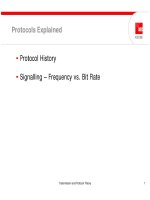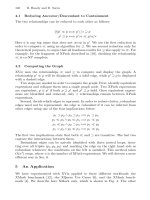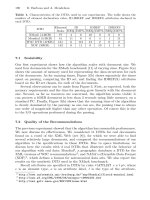Tài liệu Acronyms and Abbreviations pptx
Bạn đang xem bản rút gọn của tài liệu. Xem và tải ngay bản đầy đủ của tài liệu tại đây (106.81 KB, 6 trang )
B-1
Cisco PIX Firewall and VPN Configuration Guide
78-13943-01
APPENDIX
B
Acronyms and Abbreviations
This appendix lists the acronyms and abbreviations used in this document. Refer to the Cisco PIX
Firewall Command Reference for information on the commands described in this section.
For more information on acronyms used in this guide, refer to the Internetworking Terms and Acronyms
guide, which can be viewed online at the following website:
/>Table B-1 Acronyms and Abbreviations
Acronym Description
AAA authentication, authorization, and accounting.
ACE Access Control Entry
ACL access control list
AH Authentication Header.
ARP Address Resolution Protocol—A low-level TCP/IP protocol that maps a node’s
hardware address (called a “MAC” address) to its IP address. Defined in RFC 826.
An example hardware address is 00:00:a6:00:01:ba. (The first three groups specify
the manufacturer, the rest identify the host’s motherboard.)
BGP Border Gateway Protocol—While PIX Firewall does not support use of this
protocol, you can set the routers on either side of the PIX Firewall to use RIP
between them and then run BGP on the rest of the network before the routers.
BOOTP Bootstrap Protocol—Lets diskless workstations boot over the network and is
described in RFC 951 and RFC 1542.
CA certification authority.
CHAP Challenge Handshake Authentication Protocol. Security feature supported on
lines using PPP encapsulation that prevents unauthorized access.
CPP Combinet Proprietary Protocol.
chargen Character Generation—Via TCP, a service that sends a continual stream of
characters until stopped by the client. Via UDP, the server sends a random number
of characters each time the client sends a datagram. Defined in RFC 864.
conn Connection slot in PIX Firewall—Refer to the xlate command page for more
information.
CPU Central Processing Unit.
CRL certificate revocation list.
B-2
Cisco PIX Firewall and VPN Configuration Guide
78-13943-01
Appendix B Acronyms and Abbreviations
DES Data Encryption Standard.
DHCP Dynamic Host Configuration Protocol.
DNS Domain Name System—Operates over UDP unless zone file access over TCP is
required.
DoS Denial of Service.
EEPROM Electrically Erasable Programmable Read-Only Memory.
EGP Exterior Gateway Protocol—While PIX Firewall does not support use of this
protocol, you can set the routers on either side of the PIX Firewall to use RIP
between them and then run EGP on the rest of the network before the routers.
EIGRP Enhanced Interior Gateway Routing Protocol—While PIX Firewall does not
support use of this protocol, you can set the routers on either side of the
PIX Firewall to use RIP between them and then run EIGRP on the rest of the
network before the routers.
ESP Encapsulating Security Protocol. Refer to RFC 1827 for more information.
FDDI Fiber Distributed Data Interface—Fiber optic interface.
FTP File Transfer Protocol.
gaddr Global address—An address set with the global and static commands.
GRE Generic Routing Encapsulation protocol—Commonly used with Microsoft’s
implementation of PPTP.
HSRP Hot-Standby Routing Protocol.
HTTP Hypertext Transfer Protocol—The service that handles access to the World Wide
Web.
https Secure Hypertext Transfer Protocol.
IANA Internet Assigned Number Authority—Assigns all port and protocol numbers for
use on the Internet. You can view port numbers at the following site:
/>You can view protocol numbers at the following site:
/>ICMP Internet Control Message Protocol—This protocol is commonly used with the
ping command. You can view ICMP traces through the PIX Firewall with the
debug trace on command. Refer to RFC 792 for more information.
IFP Internet Filtering Protocol.
IGMP Internet Group Management Protocol.
IGRP Interior Gateway Routing Protocol.
IKE Internet Key Exchange.
IKMP Internet Key Management Protocol.
ISAKMP Internet Security Association and Key Management Protocol.
IP Internet Protocol.
IPCP IP Control Protocol. Protocol that establishes and configures IP over PPP.
Table B-1 Acronyms and Abbreviations (continued)
Acronym Description
B-3
Cisco PIX Firewall and VPN Configuration Guide
78-13943-01
Appendix B Acronyms and Abbreviations
IPinIP IP-in-IP encapsulation protocol.
IPSec IP Security Protocol efforts in the IETF (Internet Engineering Task Force).
IRC Internet Relay Chat protocol—The protocol that lets users access chat rooms.
ISAKMP Internet Security Association and Key Management Protocol.
KDC Key Distribution Center.
L2TP Layer Two Tunneling Protocol
laddr Local address—The address of a host on a protected interface.
MD5 Message Digest 5—An encryption standard for encrypting VPN packets. This
same encryption is used with the aaa authentication console command to encrypt
Telnet sessions to the console.
MIB Management Information Base—Used with SNMP.
MPPE Microsoft Point-To-Point Encryption.
MS-CHAP Microsoft CHAP (Challenge Handshake Authentication Protocol). See “CHAP”
for more information.
MSRPC Microsoft Remote Procedure Call.
MTU maximum transmission unit—The maximum number of bytes in a packet that can
flow efficiently across the network with best response time. For Ethernet, the
default MTU is 1500 bytes, but each network can have different values, with serial
connections having the smallest values. The MTU is described in RFC 1191.
NAT Network Address Translation.
NetBIOS Network Basic Input Output System—An application programming interface
(API) that provides special functions for PCs in local-area networks (LANs).
NIC Network Information Center.
NNTP Network News Transfer Protocol—News reader service.
NOS Network Operating System.
NTP Network Time Protocol—Set system clocks via the network.
NVT Network virtual terminal.
OSPF Open Shortest Path First protocol.
PAP Password Authentication Protocol. Authentication protocol that lets PPP peers
authenticate one another.
PAT Port Address Translation.
PDM PIX Device Manager.
PFS perfect forward secrecy.
PFSS PIX Firewall Syslog Server.
PIX Private Internet Exchange.
PKI Public Key Infrastructure.
POP Post Office Protocol.
PPPoE Point-to-Point Protocol over Ethernet.
Table B-1 Acronyms and Abbreviations (continued)
Acronym Description
B-4
Cisco PIX Firewall and VPN Configuration Guide
78-13943-01
Appendix B Acronyms and Abbreviations
PPP Point-to-Point Protocol. Provides PIX Firewall-to-router and host-to-network
connections over synchronous and asychronous circuits.
PPTP Point-to-Point Tunneling Protocol. RFC 2637 describes the PPTP protocol.
RA registration authority.
RADIUS Remote Authentication Dial-In User Service—User authentication server
specified with the aaa-server command.
RAS The registration, admission, and status protocol. Provided with H.323 support.
RC4 RC4 is stream cipher designed by Rivest for RSA Data Security, Inc. It is a
variable key-size stream cipher with byte-oriented operations. The algorithm is
based on the use of a random permutation.
RFC Request For Comment—RFCs are the defacto standards of networking protocols.
RIP Routing Information Protocol.
RPC Remote Procedure Call.
RSA Rivest, Shamir, and Adelman. RSA is the trade name for RSA Data Security, Inc.
RTP Real-Time Transport Protocol.
RTCP RTP Control Protocol.
RTSP Real Time Streaming Protocol.
SA security association.
SCCP Simple (Skinny) Client Control Protocol
SDP Session Description Protocol.
SIP Session Initiation Protocol.
SSH Secure Shell.
SMR Stub Multicast Routing.
SMTP Simple Mail Transfer Protocol—Mail service. The fixup protocol smtp command
enables the Mail Guard feature. The PIX Firewall Mail Guard feature is compliant
with both the RFC 1651 EHLO and RFC 821 section 4.5.1 commands.
SNMP Simple Network Management Protocol—Set attributes with the snmp-server
command.
SPC Shared Profile Component.
SPI Security Parameter Index—A number which, together with a destination IP
address and security protocol, uniquely identifies a particular security association.
SQL*Net SQL*Net is a protocol Oracle uses to communicate between client and server
processes. (SQL stands for Structured Query Language.) The protocol consists of
different packet types that PIX Firewall handles to make the data stream appear
consistent to the Oracle applications on either side of the firewall. SQL*Net is
enabled with the fixup protocol sqlnet command, which is provided in the default
configuration.
SYN Synchronize sequence numbers flag in the TCP header.
TACACS+ Terminal Access Controller Access Control System Plus.
TCP Transmission Control Protocol. Refer to RFC 793 for more information.
Table B-1 Acronyms and Abbreviations (continued)
Acronym Description
B-5
Cisco PIX Firewall and VPN Configuration Guide
78-13943-01
Appendix B Acronyms and Abbreviations
TurboACL Turbo Access Control List—A feature introduced with PIX Firewall version 6.2
that improves the performance of large ACLs.
TFTP Trivial File Transfer Protocol.
Triple DES Triple Data Encryption Standard. Also known as 3DES.
uauth User authentication.
UDP User Datagram Protocol.
URL Universal Resource Locator.
UUIE user-user information element.
VPDN virtual private dial-up network.
VPN Virtual Private Network.
WWW World Wide Web.
Xauth extended authentication.
XDMCP X Display Manager Control Protocol.
xlate Translation slot in PIX Firewall.
Table B-1 Acronyms and Abbreviations (continued)
Acronym Description









